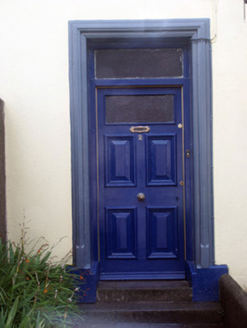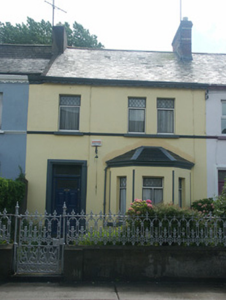Survey Data
Reg No
15505058
Rating
Regional
Categories of Special Interest
Architectural
Original Use
House
In Use As
House
Date
1905 - 1910
Coordinates
305047, 121318
Date Recorded
05/07/2005
Date Updated
--/--/--
Description
Terraced two-bay two-storey house, built 1909, with canted bay window to right ground floor. Refenestrated, pre-1992. One of a group of four forming part of a group of five. Pitched (shared) slate roof (half-polygonal roof to bay window) with terracotta ridge tiles (pressed lead ridges to bay window), red brick Running bond (shared) chimney stack having yellow brick stringcourses, stepped capping supporting yellow terracotta pots, rendered coping, and cast-iron rainwater goods having profiled apron. Rendered walls with bull-nose corners to bay window rising to moulded cornice, and moulded stringcourse to first floor. Square-headed window openings (paired to right first floor) with cut-granite sills forming part of stringcourse to first floor, and replacement aluminium casement windows, pre-1992 (replacing one-over-one timber sash windows). Square-headed door opening with two cut-granite steps, cut-granite padstones supporting moulded rendered surround, and glazed timber panelled door having overlight. Set back from line of street in own grounds with rendered boundary wall to forecourt having cut-granite coping supporting decorative cast-iron railings, and cast-iron colonette piers on step supporting decorative cast-iron gate [VO].
Appraisal
A modest-scale house built as one of a group of four identical units (with 15505059 - 61) representing part of a larger ensemble alongside an earlier (1890) house (15505057) making a pleasing visual impression of formal uniform quality in King Street Upper. Exhibiting a somewhat sophisticated design ethos, the architectural value of the house is established by attributes redolent of the period of construction including the compact plan form, the slight diminishing in scale of the openings on each floor, the expressed bay window, the subtle rendered accents with particular emphasis on a Classical doorcase, and so on: meanwhile, attractive iron work further enhances the positive contribution made by the house on the street scene. However, although the elementary composition survives in place together with much of the historic or original fabric, the external expression of the house together with the collective assemblage has not benefited from the introduction of replacement fittings to most of the openings.



